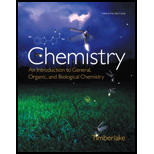
Concept explainers
Calculate each of the following:
a. number of C atoms in 0.500 mole of C
b. number of
c. moles of Fe in
d. moles of
Want to see the full answer?
Check out a sample textbook solution
Chapter 7 Solutions
Chemistry: An Introduction to General, Organic, and Biological Chemistry (12th Edition) - Standalone book
- 3.78 Consider two samples of liquid: I mole of water (H2O) and 1 mole of ethanol. Answer each of the following questions. Note that none of these should require significant calculations. (a) Which sample contains more atoms? (b) Which sample contains more molecules? (c) Which sample has a larger mass?arrow_forwardOnly Answer questions 1 - d and 2 a-b Answers to questions 1 a-c a. Number of moles of O2 = 0.0613 mol b. Number of moles of MClO3= 0.040836 mol c. The Molar mass is 122.44 g/mol , The mystery substance is KClO3arrow_forwardThe formula for dioxygen difluoride is O₂ F2. a. How many grams of oxygen are present in 1.69 moles of dioxygen difluoride? I grams b. How many moles of fluorine are present in 1.07 grams of dioxygen difluoride? molesarrow_forward
- 1211 2. 1ouprofen, the anit-inflammatory ingredient in Advil, has the formula C13HIBO2. a. How many molecules are in 0.200 mole ibuprofen? b. How many H atoms are in 0.100 mole ibuprofen? c. How many moles of ibuprofen contain 7.4x10²5 atoms of C? d. What is the molar mass of ibuprofen?arrow_forwardWhat is the empirical formula for the given MF:C5HI12 O a. C5H12 O b. CH O c. CH6arrow_forward. Lycopene (C40H56) is an antioxidant molecule that is thought to slow aging and reduce the risk of cancer with a minimum daily intake of 6.5 mg. a. Determine the empirical formula for lycopene. b. How many moles of lycopene are required to meet the minimum daily dose?arrow_forward
- How many moles of carbon are in 7.50 g of the compound C3H4O2? Atomic Mass: C = 12.01; H = 1.008; O =16.00 g/mole Select one: of O a. 0.104 mole O b. 0.416 mole tion O c. 0.208 mole O d. 0.312 mole Next page 7:03 PM 4/7/2021arrow_forwardThe formula for nitrogen dioxide is NO₂. a. How many grams of nitrogen are present in 3.85 moles of nitrogen dioxide? grams b. How many moles of oxygen are present in 4.29 grams of nitrogen dioxide? molesarrow_forwardCalculate the mass percent composition of carbon in each carbon-containing compound show work? a. CH4 b. C2H6 c. C2H2 d. C2H5Clarrow_forward
- The formula for disulfur decafluoride is S₂ F 10. a. How many grams of sulfur are present in 3.63 moles of disulfur decafluoride? grams b. How many moles of fluorine are present in 3.83 grams of disulfur decafluoride? molesarrow_forward6. Calculate the following quantities in 0.185 mole of C,H140. a. moles of C b. moles of 0 c. atoms ofH 7. Calculate the molar mass of the following (a) Zn(C2H3O2)2 b. Ca3(C6H5O7)2 8. Calculate the mass in grams of 2.08 moles of (NH4)2SO4arrow_forward14. How many moles are there in 45 g of Cl₂? 15. Change 34 g of lithium to moles. 16. What is the weight of a 4.30 moles of sodium? 17. What is the weight of 1.75 mole of CaO? 18. How many moles are there in 85.3 g of P5010? 19. Change 0.566 g of silver chloride to moles. zslusalom 01 20. How many moles is 12.5 g of magnesium hydroxide? 1916 lo amods ynsm wol.es 21. How many moles is 1.46 g of hydrogen gas? Think about the formula for elemental hydrogen! 22. How many grams are in 4.3 moles of ammonium chloride? Fro es it 4 m e a can Oarrow_forward

 Chemistry for Engineering StudentsChemistryISBN:9781337398909Author:Lawrence S. Brown, Tom HolmePublisher:Cengage Learning
Chemistry for Engineering StudentsChemistryISBN:9781337398909Author:Lawrence S. Brown, Tom HolmePublisher:Cengage Learning Chemistry for Engineering StudentsChemistryISBN:9781285199023Author:Lawrence S. Brown, Tom HolmePublisher:Cengage Learning
Chemistry for Engineering StudentsChemistryISBN:9781285199023Author:Lawrence S. Brown, Tom HolmePublisher:Cengage Learning


